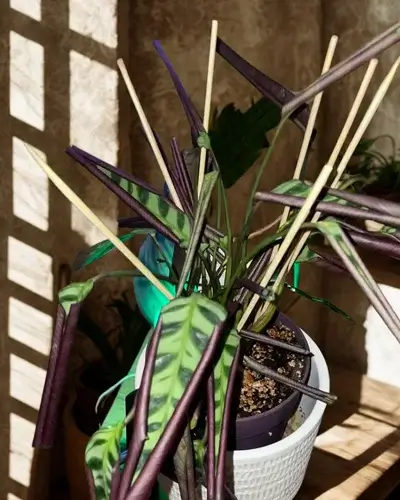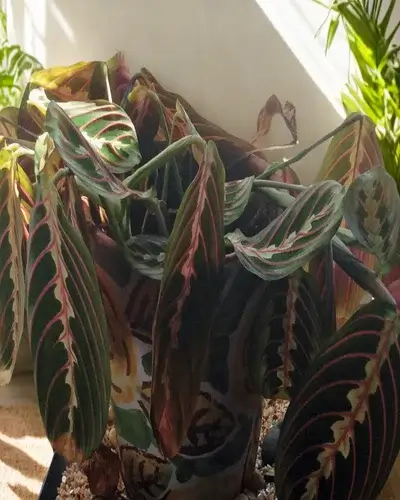Common Fishbone Prayer Plant Problems (and How to Fix Them Fast)

Wilting, curling, or yellowing leaves on your Fishbone Prayer Plant usually mean issues with water, light, or humidity. The good news? Most problems are easy to fix with consistent care and the right environment.
What does an unhealthy Fishbone Prayer Plant look like?
Look for these common red flags:
- Leaves curling inwards or folding at night and staying that way
- Brown edges or tips
- Drooping or limp stems
- Yellow patches or fading color
- Slow or no new growth
- Sticky spots or webbing from pests
Each symptom is your plant’s SOS. Let’s break down exactly what’s going wrong—and how to fix it.
Why are my Fishbone Prayer Plant leaves curling?
Curling leaves are usually a cry for water or humidity. But they can also signal over-fertilizing or too much sun.

Quick Fixes:
- Water when top inch of soil is dry
- Boost humidity (humidifier or pebble tray)
- Check if it’s near a heat vent or window
- Rinse off any fertilizer salt buildup
Pro Tip: Fishbone Prayer Plants close their leaves at night—but if they stay curled during the day, it’s a sign of stress.
Why are the leaf tips turning brown?
Brown tips mean dry air, inconsistent watering, or too much light. Fishbone Prayer Plants are sensitive to dry indoor air and tap water chemicals.
Quick Fixes:
- Use filtered or distilled water
- Water on a regular schedule (don’t let it go bone dry)
- Keep away from direct sun or radiators
- Group with other plants to raise humidity
Pro Tip: Trim brown tips with clean scissors, but don’t cut into the healthy green part.
What causes yellow leaves on a Fishbone Prayer Plant?
Yellowing leaves often mean overwatering or low light. Sometimes it’s just old leaves dying off naturally.
Quick Fixes:
- Feel the soil—if soggy, wait longer to water
- Use well-draining soil with perlite or orchid bark
- Move to a brighter spot with indirect light
- Remove yellow leaves to redirect energy to healthy ones
Pro Tip: Soggy roots can kill your plant fast, so always empty the saucer after watering.
Why is my Fishbone Prayer Plant drooping or wilting?
Drooping usually means root trouble—either too much or too little water.

Quick Fixes:
- Check root health: gently unpot and inspect
- If roots are black/mushy → repot with fresh soil
- If soil is dry → water thoroughly and drain excess
- Adjust watering to be consistent
Pro Tip: If it perks up within a few hours after watering, underwatering was the problem.
Why isn’t my Fishbone Prayer Plant growing?
Stunted growth means it’s not getting what it needs—usually light, space, or nutrients.
Quick Fixes:
- Place in bright, indirect light (east or north window)
- Repot if rootbound (check for roots circling the pot)
- Feed monthly with a gentle liquid fertilizer (spring-summer)
- Ensure temps stay above 60°F
Pro Tip: These plants grow slowly in winter—don’t panic unless the issue continues into spring.
What pests attack Fishbone Prayer Plants?
Spider mites, aphids, and mealybugs love hiding under the striped leaves.
Signs of Infestation:
- Tiny webs or sticky residue
- Speckled or faded leaves
- Crawling bugs on stems or undersides
Fix It Fast:
- Spray with neem oil weekly
- Wipe leaves with soapy water
- Quarantine new or infested plants
Pro Tip: Regular leaf showers (in the sink or tub) keep pests away and humidity up.
Check out our Essentials Fishbone Prayer growing tips
How do I prevent Fishbone Prayer Plant problems?
Here’s your simple care checklist:
🪴 Weekly Care Routine:
- Water when top inch is dry
- Wipe leaves to keep pests away
- Rotate the pot for even growth
- Check for drooping/curling signs early
📋 Environmental Must-Haves:
- Bright, indirect light (never direct sun)
- Consistent humidity (aim for 50–60%)
- Temperatures between 65–80°F
- Airflow without cold drafts
- Well-draining soil with added perlite
Ready to master this stunning prayer plant? Get all the details in our full ctenanthe burle‑marxii care guide.
FAQs
-
Can I cut off yellow or brown leaves?
Yes—remove damaged leaves so your plant can put energy into healthy growth.
-
Is tap water bad for Fishbone Prayer Plants?
It can be. Use filtered or distilled water if your tap water is high in chlorine or fluoride.
-
Does it need fertilizer?
Light feeding during spring and summer is fine. Skip winter feeding.
Final Thoughts
Fishbone Prayer Plants (Ctenanthe burle-marxii) are sensitive but totally fixable when issues arise. Most problems—curling, drooping, yellowing—come down to watering, light, and humidity. With consistent care and fast fixes, your plant will bounce back fast.
Give it steady care and it’ll bounce back with bold stripes and rhythmic leaf movement.
